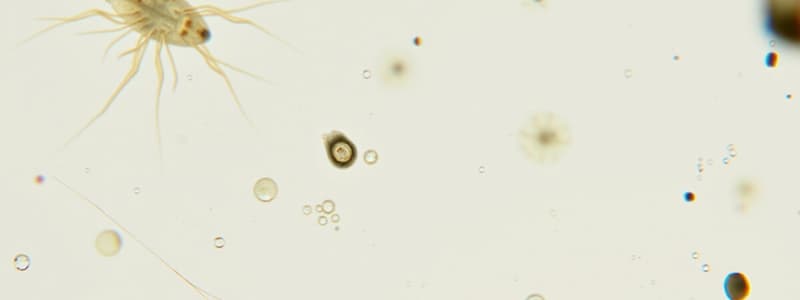Podcast
Questions and Answers
What are the characteristics of Protozoa?
What are the characteristics of Protozoa?
They are unicellular, chemoheterotrophs, have special structures for ingesting food and are capable of reproduction.
What are the 2 types of reproduction?
What are the 2 types of reproduction?
- Sexual
- Asexual
- Both A and B (correct)
- Neither A nor B
What are trophozoites?
What are trophozoites?
Any stage in a protozoa's life cycle at which they ingest food; it refers to the motile form.
What are protozoa cysts?
What are protozoa cysts?
How resistant are protozoa cysts?
How resistant are protozoa cysts?
What is excystation?
What is excystation?
How can you kill a cyst?
How can you kill a cyst?
How long can protozoa cysts live in soil or water?
How long can protozoa cysts live in soil or water?
Does a protozoa cyst go out and seek nutrients or ingest food?
Does a protozoa cyst go out and seek nutrients or ingest food?
To ingest food, do protozoa cysts use organelles?
To ingest food, do protozoa cysts use organelles?
What is a definitive host?
What is a definitive host?
What is an intermediate host?
What is an intermediate host?
What are the subphylums for Sarcomastigophora?
What are the subphylums for Sarcomastigophora?
What are examples of a Ciliata (ciliates)?
What are examples of a Ciliata (ciliates)?
What is a Sporoza, a non-motile obligate parasite?
What is a Sporoza, a non-motile obligate parasite?
How do amoebas move?
How do amoebas move?
How do flagellates move?
How do flagellates move?
What are in the Sarcomastigophora Phylum?
What are in the Sarcomastigophora Phylum?
What is contained in the subphylum Sarcodina?
What is contained in the subphylum Sarcodina?
What are free living and non-parasitic?
What are free living and non-parasitic?
What contain a nucleus and pseudopods?
What contain a nucleus and pseudopods?
In the Entamoeba histolytica, what is contained inside?
In the Entamoeba histolytica, what is contained inside?
What is the disease Amoebiasis?
What is the disease Amoebiasis?
What consumes red blood cells?
What consumes red blood cells?
Where can you see RBCs in the cytoplasm of the amoebas?
Where can you see RBCs in the cytoplasm of the amoebas?
What is histolysis?
What is histolysis?
What are the characteristics of Entamoeba histolytica?
What are the characteristics of Entamoeba histolytica?
What is a typical effect of Entamoeba histolytica?
What is a typical effect of Entamoeba histolytica?
What can Entamoeba histolytica infection lead to?
What can Entamoeba histolytica infection lead to?
What are symptoms of the above complications?
What are symptoms of the above complications?
How can it be diagnosed?
How can it be diagnosed?
What is commonly used to treat Entamoeba histolytica?
What is commonly used to treat Entamoeba histolytica?
What are diagnostic features of Entamoeba histolytica?
What are diagnostic features of Entamoeba histolytica?
What is Giardia lamblia?
What is Giardia lamblia?
What is Trichomonas vaginalis?
What is Trichomonas vaginalis?
Flashcards are hidden until you start studying
Study Notes
Characteristics of Protozoa
- Unicellular organisms
- Chemoheterotrophs: obtain energy by breaking down organic matter
- Possess structures specialized for food ingestion
- Reproduce through various modes
Types of Reproduction
- Asexual reproduction includes fission, budding, and schizogony (rapid production of trophozoites)
- Sexual reproduction occurs via conjugation
Trophozoites
- Refers to any stage where protozoa ingest food, primarily the motile form
- Motility achieved through structures like pseudopods, cilia, or flagella
Protozoa Cysts
- Non-motile stage, often the infective form, encased in a protective membrane
- Contain a thick cell wall for enhanced survival in harsh environments
Resistance of Protozoa Cysts
- Not as resilient as bacterial endospores
Excystation
- The process by which a trophozoite emerges from a cyst
Killing Cysts
- Cysts can be destroyed by boiling
Duration of Cyst Survival
- Protozoa cysts can survive for months in soil or water
Nutrient Absorption
- Protozoa cysts do not seek out or ingest food actively, but absorb nutrients
Lack of Organelles in Cysts
- Cysts lack organelles necessary for food digestion
Definitive Host
- The host in which a parasite completes its sexual life cycle, e.g., Anopheles mosquito for Plasmodium
Intermediate Host
- A temporary host where the organism lives but does not complete its sexual life cycle, humans often serve this role
Subphylums for Sarcomastigophora
- Sarcodina (amoebas) and Mastigophora (flagellates)
Examples of Ciliates
- Paramecium spp. and Balantidium (parasitic ciliate causing disease)
Sporozoa Classification
- Apicomplexa as a group of non-motile obligate parasites
Movement Mechanisms
- Amoebas move using pseudopods
- Flagellates utilize flagella for movement
Contents of Sarcomastigophora Phylum
- Includes amoebas and flagellates
Sarcodina Subphylum Contents
- Exclusively contains amoebas
Free-Living and Non-Parasitic Examples
- Species like Amoeba spp.
Structure of Amoebas
- Characterized by a nucleus and pseudopods (false feet)
Features of Entamoeba histolytica
- Contains a nucleus and food vacuoles
Amoebiasis Disease Overview
- A globally prevalent disease, risk increases upon entering regions like Mexico
RBC Consumption
- Entamoeba histolytica consumes red blood cells
Detection of RBCs
- Presence observed in fresh diarrheal specimens
Histolysis
- Refers to the destruction of tissue
Pathogenic Behavior of Entamoeba histolytica
- Invades intestinal walls and can spread to other vital organs (liver, lungs, brain, eyes)
Effects of Entamoeba histolytica Infection
- Can cause liver abscesses, potentially fatal if untreated
Complications from Entamoeba Histolytica Infection
- Results in amoebiasis or amoebic dysentery
Symptoms of Complications
- Symptoms include dysentery (diarrhea), weight loss, fatigue, and abdominal pain
Diagnosis of Infection
- Diagnosis through stool samples; fresh fecal smears show trophozoites and cysts in ordinary stool samples
Treatment for Entamoeba Histolytica
- Commonly treated with the antibiotic Metronidazole
Diagnostic Features of Entamoeba Histolytica
- Characterized by ingested red blood cells and bull's eye karyosome
Giardia lamblia Characteristics
- Intestinal parasite featuring nuclei and flagella
Trichomonas vaginalis Characteristics
- Urogenital parasite also featuring a nucleus and flagella
Studying That Suits You
Use AI to generate personalized quizzes and flashcards to suit your learning preferences.




